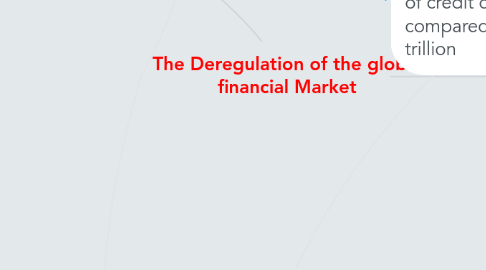
1. A contract used to insure the buyer of a bond against default by the bond issuer. This is what got Joseph Cassano and AIG Financial Products into so much trouble.
2. The risk was not just confined to mortgages. All kinds of debt were repackaged and resold as collateralized debt obligations.
2.1. security backed/licked to diversify pool of credit
3. Banks and hedge funds made so much money selling mortgage-backed securities
4. large banks led the way towards aggressiveness and risk taking and began pressing at the boundaries of allowable activities because the rules were also ‘’relaxed” The banks could now expand and compete in a way they could not before, and they took advantage of it.
4.1. The original reasons for regulations of banks were to protect depositors and consumers, maintain monetary stability, and provide an efficient and competitive financial system
4.1.1. Glass-Steagall Act of 1933 prohibited commercial banks from being involved with investment banks. Creating the separation between commercial banks and investment banks
5. Starting in the 1980s, considerable deregulation took place in banking. Banks were deregulated through:
5.1. The Depository Institutions Deregulation and Monetary Control Act allowed similar banks to merge and set any interest rate
5.2. The Garn–St. Germain Depository Institutions Act allowed Adjustable-rate mortgages
5.3. The Gramm–Leach–Bliley Act of 1999 allowed commercial and investment banks to merge
5.3.1. Many single out the the Gramm–Leach–Bliley Act as very significant reason for the crisis
5.4. In 2000, President Clinton signed the Commodities Futures Modernization Act of 2000 into law which banned the further regulation of the derivatives market.
5.5. The Gramm-Rudman Act was a major factor for the crash. It allowed banks to engage in trading profitable derivatives that they sold to investors.
5.5.1. These mortgage-backed securities needed home loans as collateral. The derivatives created an insatiable demand for more and more mortgages.
5.5.1.1. The banks had chopped up the original mortgages and resold them in tranches. That made the derivatives impossible to price. They thought an insurance product called credit default swaps protected them.
6. The history of deregulation
6.1. It began in the 1960s because there was a new wave of bankers who had not experienced the Great Depression and wanted more competition, especially from foreign banks, and innovation.
7. The cause.
8. The acts
9. Credit default swap
10. Mortgage-backed security
11. Mortgage-backed securities allow lenders to bundle loans into a package and resell them.
12. Repackaging of risk
13. Credit obligations
14. derivatives
15. causes
16. causes
17. causes
18. causes
19. causes
20. effects
21. effects
22. effects
23. initial cause
24. causes
25. 10 TERM
26. SOURCE 3
27. WORK CITED
28. WORK CITED
29. When a bank is able to move mortgages off the books, it frees up room for more lending capital. With investors encouraged by the traditional strength of the housing market and the ratings on MBS
29.1. investors encouraged by the traditional strength of the housing market and the ratings on MBS there was demand
29.1.1. eventually the market dried up because the amount of non-payment and people started to unload their MBS
29.1.1.1. causing many banks and financial institutions to reach insolvency
30. Adjustable Mortgage rates
30.1. ARMs had shorter fixed-rate periods, higher lifetime caps or were given with no money down or just stated income
30.1.1. regulation egulation because it keeps banks from taking advantage of the poor or less educated
30.1.1.1. They started to default and fall in value
31. The effects
32. Before the financial crisis of 2008,The value of credit default swaps stood at $45 trillion compared In mid-2010, the value was 26. trillion
32.1. Lehman brother
32.1.1. the biggest casualty was Lehman Brothers investment bank, which owed $600 billion in debt, out of which $400 billion was covered by CDS
32.1.1.1. The investment bank owed $600 billion in debt. Of that, $400 billion was "covered" by credit default swaps.
32.1.1.1.1. when they decclairedred bankruptcy AIG did not have an ugh money
32.1.1.1.2. the world's largest bond fund American International Group, They took on the Lehman credit risk in exchange for a regular quarterly payment that seemed at the time to be a fair premium

